from typing import *
import numpy as np
from qiskit.quantum_info import Statevector, Operator
from qiskit_aer import AerSimulator
from qiskit.visualization import plot_histogram
from qiskit import QuantumCircuit
sim = AerSimulator()
from util import zero, one, Pretty
Foundations II: Measurement in Multi-Qubit Systems#
In this notebook, we’ll introduce measurement on multi-qubit systems via measurement operators.
References
Born Rule#
We can generalize the Born rule to the multi-qubit setting. In particular, if
then we obtain \(\overline{i}\) with probability \(|\alpha_i|^2\).
Example#
Let’s reason this through using the Bell state
qc_e1 = QuantumCircuit(2, 2)
qc_e1.h(1)
qc_e1.cx(1, 0)
qc_e1.measure(0, 0); qc_e1.measure(1, 1)
qc_e1.draw(output="mpl", style="iqp")
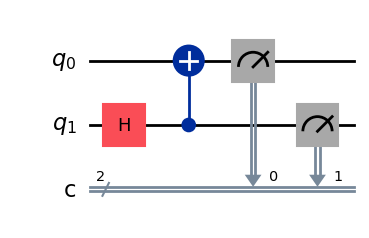
After measurement, we obtain
\(|00\rangle\) with probability \(0.5\) and
\(|11\rangle\) with probability \(0.5\).
results = sim.run(qc_e1, shots=1024).result()
answer = results.get_counts()
plot_histogram(answer)
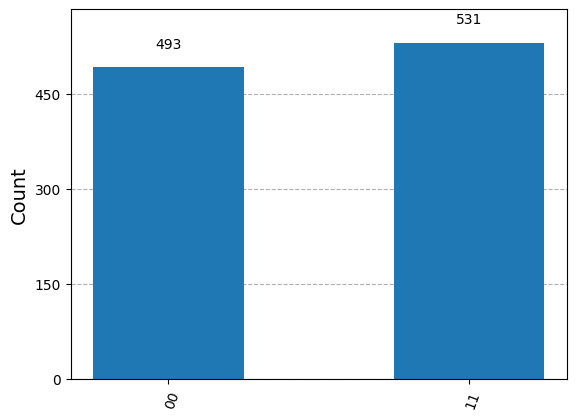
Partially Measuring a System#
In a multi-qubit setting, we can also choose to only measure one of the qubits. For instance, in the example above, we may choose to only measure one of the qubits (shown below). To describe this state of affairs, we can introduce measurement more generally via measurement operators.
qc_e1 = QuantumCircuit(2, 1)
qc_e1.h(1)
qc_e1.cx(1, 0)
qc_e1.measure(0, 0)
qc_e1.draw(output="mpl", style="iqp")
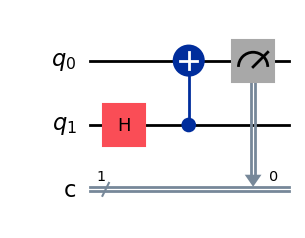
Measurement Operators#
A square matrix \(\Pi\) is called a measurement operator if
\(\Pi = \Pi^\dagger\), i.e., \(\Pi\) is Hermitian.
\(\Pi^2 = \Pi\), i.e., \(\Pi\) is idempotent.
Examples#
We give a few examples of measurement operators now.
Pi1 = np.array([
[1.0, 0.0],
[0.0, 1.0]
])
print("Hermitian check", np.allclose(Pi1, np.conjugate(Pi1.transpose())))
print("Idempotent check", np.allclose(Pi1 @ Pi1, Pi1))
Hermitian check True
Idempotent check True
Pi2 = np.array([
[1.0, 0.0],
[0.0, 0.0]
])
print("Hermitian check", np.allclose(Pi2, np.conjugate(Pi2.transpose())))
print("Idempotent check", np.allclose(Pi2 @ Pi2, Pi2))
Hermitian check True
Idempotent check True
Measurement Operators from Orthogonal Vectors#
Given an orthogonal set of vectors \(\{\psi_1, \dots, \psi_n\}\), the matrix
is a measurement operator. This gives us an easy to construct measurement operators since we can choose the orthogonal vectors to be the computational basis. Here are a few examples.
psi1 = 1/np.sqrt(2)*zero + 1/np.sqrt(2)*one
psi2 = 1/np.sqrt(2)*zero - 1/np.sqrt(2)*one
print("Orthogonality check:", np.allclose(0, np.dot(psi1, psi2)))
# Constructing measurement operator
Pi3 = np.outer(psi1, psi1) + np.outer(psi2, psi2)
Pretty(Pi3)
Orthogonality check: True
print("Hermitian check", np.allclose(Pi3, np.conjugate(Pi3.transpose())))
print("Idempotent check", np.allclose(Pi3 @ Pi3, Pi3))
Hermitian check True
Idempotent check True
psi1 = 1/np.sqrt(2)*(zero^zero) + 1/np.sqrt(2)*(one^one)
psi2 = 1/np.sqrt(2)*(zero^one) - 1/np.sqrt(2)*(one^zero)
print("Orthogonality check", np.dot(psi1, psi2))
# Constructing measurement operator
Pi4 = np.outer(psi1, psi1) + np.outer(psi2, psi2)
Pretty(Pi4)
Orthogonality check 0j
print("Hermitian check", np.allclose(Pi4, np.conjugate(Pi4.transpose())))
print("Idempotent check", np.allclose(Pi4 @ Pi4, Pi4))
Hermitian check True
Idempotent check True
Optional: Checking that the formula is well-defined.#
We perform a quick check that the matrix constructed as above is both Hermitian and idempotent.
The Hermitian property is verified with the following computation.
The idempotent condition is verified with the following computation.
Measuring with Measurement Operators#
A collection \(\{\Pi_1, \dots \Pi_m\}\) of measurement operators is complete if
where \(I\) is the identity matrix. We can perform measurement with a complete set of measurement operators.
We obtain the result associated with \(\Pi_k\) with probability
The resulting state after measurement with \(\Pi_k\) is
Example: Measurement in computational basis with 1 qubit#
Let
\(\Pi_0 = |0\rangle\langle 0|\) and
\(\Pi_1 = |1\rangle\langle 1|\).
Then
is a set of measurement operators.
# Measurement operators
Pi0 = np.outer(zero, zero)
Pi1 = np.outer(one, one)
Pis = Pi0 + Pi1
print("Is valid measurement operator:", np.allclose(np.eye(2), Pis.conj().T @ Pis))
Pretty(Pi0 + Pi1) # Check that it is identity
Is valid measurement operator: True
Pretty(Pi0)
Pretty(Pi1)
Let us now see what the result of measurement with this collection of measurement operators accomplishes. To see this, we’ll use the state in equal superposition.
psi = np.array(1/np.sqrt(2.)*zero + 1/np.sqrt(2.)*one)
Statevector(psi).draw("latex")
We see that we obtain \(0\) with probability 0.5 and \(1\) with probability 0.5
ms = [Pi0 @ psi, Pi1 @ psi] # Perform measurement
ps = [np.linalg.norm(m)**2 for m in ms] # Probabilities
[f"outcome = {outcome:01b} with probability {prob}" for outcome, prob in zip(range(2), ps)]
['outcome = 0 with probability 0.4999999999999999',
'outcome = 1 with probability 0.4999999999999999']
We can check this with a simulation.
qc = QuantumCircuit(1, 1)
qc.initialize(psi)
qc.measure(0, 0)
qc.draw(output="mpl", style="iqp")
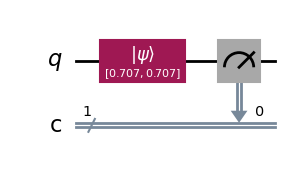
qc = QuantumCircuit(1, 1)
qc.initialize(psi)
qc.measure(0, 0)
results = sim.run(qc, shots=1024).result()
plot_histogram(results.get_counts())

Example: Measurement in computational basis with 2 qubits#
Let
\(\Pi_{00} = |00\rangle\langle 00|\),
\(\Pi_{01} = |01\rangle\langle 01|\),
\(\Pi_{10} = |10\rangle\langle 10|\), and
\(\Pi_{11} = |11\rangle\langle 11|\),
Then
forms a set of measurement operators.
# Measurement operators
zz = zero^zero; zo = zero^one; oz = one^zero; oo = one^one
Pi00 = np.outer(zz, zz)
Pi01 = np.outer(zo, zo)
Pi10 = np.outer(oz, oz)
Pi11 = np.outer(oo, oo)
Pis = Pi00 + Pi01 + Pi10 + Pi11
print("Is valid measurement operator:", np.allclose(np.eye(4), Pis.conj().T @ Pis))
Pretty(Pi00 + Pi01 + Pi10 + Pi11) # Check that it is identity
Is valid measurement operator: True
We’ll use two qubits in equal superposition to illustrate what occurs with measurement.
# Create equal superposition
psi = np.array(1/np.sqrt(4.)*zz + 1/np.sqrt(4.)*zo + 1/np.sqrt(4.)*oz + 1/np.sqrt(4.)*oo)
Statevector(psi).draw("latex")
# Perform measurement
ms = [Pi00 @ psi, Pi01 @ psi, Pi10 @ psi, Pi11 @ psi]
ps = [np.linalg.norm(m)**2 for m in ms] # Probabilities
[f"outcome = {outcome:02b} with probability {prob}" for outcome, prob in zip(range(4), ps)]
['outcome = 00 with probability 0.25',
'outcome = 01 with probability 0.25',
'outcome = 10 with probability 0.25',
'outcome = 11 with probability 0.25']
As before, we can also check that this matches what we obtain with simulation.
qc = QuantumCircuit(2, 2)
qc.initialize(psi)
qc.measure(0, 0); qc.measure(1, 1)
results = sim.run(qc, shots=1024).result()
plot_histogram(results.get_counts())
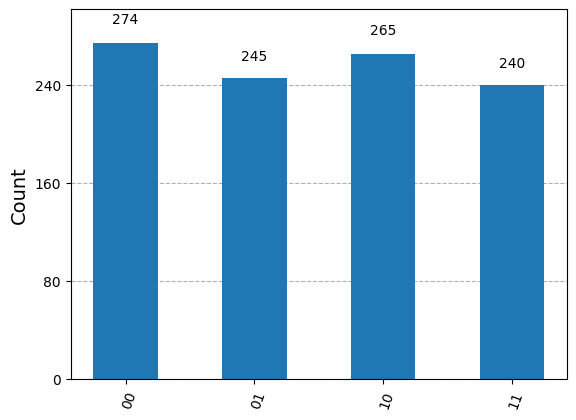
Partial Measurement with Measurement Operators#
We can now revist partial measurement. For convenience, we reproduce the circuit with partial measurement below.
qc_e1.draw(output="mpl", style="iqp")

Intuitive reasoning#
After the application of the circuit, we have the Bell state
If we observe a \(|0\rangle\) after we measure the first qubit, then the second qubit should be a \(|0\rangle\) due to entanglement.
Similarly, if we observe a \(|1\rangle\) after we measure the first qubit, then the second qubit should be a \(|1\rangle\), also due to entanglement.
More formally with measurement operators#
To use the framework of measurement operators to describe the situation of partial measurement, we’ll need to concoct a set of measurement operators that do not measure qubit \(|q_1\rangle\). Towards this end, let
\(\Pi_{*0} = |00\rangle\langle 00| + |10\rangle\langle 10|\) and
\(\Pi_{*1} = |01\rangle\langle 01| + |11\rangle\langle 11|\).
Then
is complete. The * indicates a wildcard, meaning that we do not care what we obtain for the qubit we do not measure.
Pi0s = np.outer(zz, zz) + np.outer(oz, oz) # Pi0s only observes 1st qubit, and we get 0
Pi1s = np.outer(zo, zo) + np.outer(oo, oo) # Pi1s only observes 1st qubit, and we get 1
Pretty(Pi0s + Pi1s)
psi = np.array(1/np.sqrt(2)*zz + 1/np.sqrt(2)*oo)
Statevector(psi).draw("latex")
ms = [
Pi0s @ psi,
Pi1s @ psi,
]
ps = [np.linalg.norm(m)**2 for m in ms]
# Probabilities of observing for first qubit
[f"outcome = {outcome:01b} with probability {prob}" for outcome, prob in zip([0, 1], ps)]
['outcome = 0 with probability 0.4999999999999999',
'outcome = 1 with probability 0.4999999999999999']
# If we observe a 0, then the state is
psi = ms[0] / np.linalg.norm(ms[0])
Statevector(psi).draw("latex")
# If we observe a 1, then the state is
psi = ms[1] / np.linalg.norm(ms[1])
Statevector(psi).draw("latex")
Summary#
We introduced the notion of measurement operators.
We demonstrated how to reason about measurement in multi-qubit systems with measurement operators.
